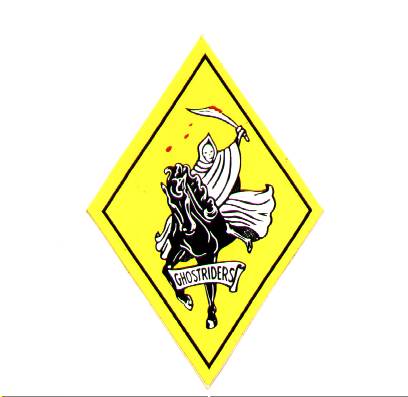

Image Courtesy of Darryl Shaw |
VF-142's history can be traced back to 1948, when it was created as VF-193. Before switching to the F-14 the squadron was flying the F-4J Phantom II, however in 1974 the squadron's 'Rhino' days came to an end, as the transition process to the then brand new F-14A began. While transitioning from one plane to another the squadron transitioned from one base to another, moving from the Pacific fleet's Miramar base to become part of the Atlantic fleet, based at Oceana. Once the transition was complete the squadron's first cruise began in April 1976, taking place onboard the USS America (CV-66). After this initial cruise the squadron shifted air wings, becoming part of CVW-7 onboard USS Dwight D. Eisenhower (CVN-69). VF-142 has the unique distinction of being the first F-14 Tomcat squadron to win the Battle 'E', during the late 1970's.
In April/May of 1989 the squadron became one of those lucky enough to upgrade to the F-14A+ (now F-14B) Tomcat. The aircraft were transferred to the Ghostriders from VF-74, who received newer aircraft in replacement.
The first cruise with their new mount began on the 6th of March 1990, the first time the F-14A+ had gone to sea with an operational squadron. This deployment was onboard CVN-69, USS Eisenhower, and included VF-143, also flying the F-14A+. Late in their cruise the aggression of Iraqi leader Saddam Hussein saw CVN-69 diverted to the Red Sea, where the aircraft of VF-142 and VF-143 took part in the early stages of Desert Shield. But due to the fact that the Gulf crisis had arisen late within Ike's cruise the carrier and aircraft returned to the USA before Desert Shield began, being replaced by the USS Saratoga, who herself carried the F-14A+ equipped squadrons of VF-74 and VF-103. USS Eisenhower returned to Norfolk on the 12th of September 1990.
During work ups for their next cruise VF-142 deployed to Nevada with the rest of the CVW for advanced airwing training. This deployment saw VF-142 begin to practice carrying and dropping bombs. But in mid 1991 the idea of bomb dropping was still very much in the early stages and so VF-142 only practiced with 5lb training bombs, rather than live ordnance. The cruise, on again onboard the USS Eisenhower, began in October 1991 and saw the carrier move through the Suez canal into the Persian Gulf. In January of 1992 the carrier moved out of the Gulf, through the Mediterranean and into the Northern Atlantic, eventually entering the Arctic circle to take part in NATO exercises off Norway, graphically illustrating the climatic extremes within which all naval personnel are expected to operate.
Unfortunately in the climate of budget cuts and air wing reorganisation VF-142 has gone the way of many F-14 squadrons, being disestablished in April of 1995. A rather unique memorial to the squadron could be found in the Smithsonian Aerospace Museum, which had a replica of a VF-142 ready room amongst its exhibits, although whether it is still present is uncertain.
The squadron markings took the form of a skull's head from which extended a skeletal arm brandishing a cutlass, the 'AG' tailcode generally being carried on the inside of the tail, with the A joined to the G. The image below shows a VF-142 Commanding Officer aircraft, painted in hi-vis markings. Low-vis aircraft were much the same, simply loosing the canopy hood, full colour national insignia and yellow fin flash.
 |
[Main Page] [F-14A] [F-14B] [F-14D] [Tomcat 21] [Atlantic Fleet Squadron Histories] [Pacific Fleet Squadron Histories] [F-14A Images] [F-14B Images] [F-14D Images] [F-14 Model Kits] [US Navy Air Wings] [A-6 images]